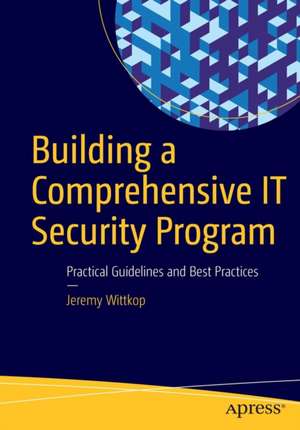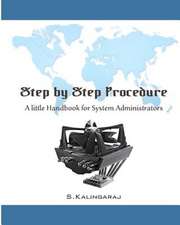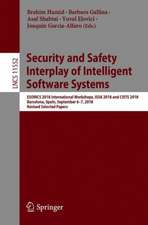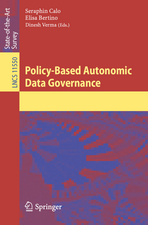Building a Comprehensive IT Security Program: Practical Guidelines and Best Practices
Autor Jeremy Wittkopen Limba Engleză Paperback – 28 iul 2016
Cybercrime continues to grow at an astounding rate. With constant coverage of cyber-attacks in the media, there is no shortage of awareness of increasing threats. Budgets have increased and executives are implementing stronger defenses. Nonetheless, breaches continue to increase in frequency and scope.
Building a Comprehensive IT Security Program shares why organizations continue to fail to securetheir critical information assets and explains the internal and external adversaries facing organizations today. This book supplies the necessary knowledge and skills to protect organizations better in the future by implementing a comprehensive approach to security.
Jeremy Wittkop’s security expertise and critical experience provides insights into topics such as:
- Who is attempting to steal information and why?
- What are critical information assets?
- How are effective programs built?
- How is stolen information capitalized?
- How do we shift the paradigm to better protect our organizations?
- How we can make the cyber world safer for everyone to do business?
Preț: 235.27 lei
Preț vechi: 294.09 lei
-20% Nou
Puncte Express: 353
Preț estimativ în valută:
45.02€ • 47.00$ • 37.26£
45.02€ • 47.00$ • 37.26£
Carte disponibilă
Livrare economică 15-29 martie
Preluare comenzi: 021 569.72.76
Specificații
ISBN-13: 9781484220528
ISBN-10: 1484220528
Pagini: 272
Ilustrații: XIX, 195 p. 13 illus., 8 illus. in color.
Dimensiuni: 178 x 254 x 12 mm
Greutate: 0.39 kg
Ediția:1st ed.
Editura: Apress
Colecția Apress
Locul publicării:Berkeley, CA, United States
ISBN-10: 1484220528
Pagini: 272
Ilustrații: XIX, 195 p. 13 illus., 8 illus. in color.
Dimensiuni: 178 x 254 x 12 mm
Greutate: 0.39 kg
Ediția:1st ed.
Editura: Apress
Colecția Apress
Locul publicării:Berkeley, CA, United States
Cuprins
Chapter 1: The Problem We Are Facing.- Chapter 2 : Protecting Critical Assets.- Chapter 3: Monetizing Risk.- Chapter 4: Security Intelligence Model.- Chapter 5: Incident Response Planning.- Chapter 6: The People Problem.- Chapter 7: Assigning Accountability.- Chapter 8: Shifting the Paradigm.- Chapter 9: The Definition of Insanity.- Chapter 10: Déjà Vu.- Chapter 11: The Information Security Community.- Chapter 12: Partnering with Governments.-
Recenzii
“This is an excellent book that covers all of the relevant topics needed for implementing a successful security program. The author clearly understands both security and business issues and explains the need for senior management involvement and how a security process must complement the overall business process. … The writing is clear and readable for nontechnical people. I highly recommend it to anyone interested in cyber security.” (Computing Reviews, May, 2017)
Notă biografică
Jeremy Wittkop is a leader in the information security industry, specifically as it relates to content and context protection. Jeremy brings insights from a variety of industries including, military and defense, logistics, entertainment, as well as information security services.
Jeremy started with Intelisecure as the leader of the Managed Services department and has overseen 1000% growth of that department by helping to solve complex Information Security challenges for organizations spanning the globe. Jeremy now leads Intelisecure's Sales Engineering team, which is responsible for architecting solution packages that include creative approaches to people, process, and technology.
Jeremy started with Intelisecure as the leader of the Managed Services department and has overseen 1000% growth of that department by helping to solve complex Information Security challenges for organizations spanning the globe. Jeremy now leads Intelisecure's Sales Engineering team, which is responsible for architecting solution packages that include creative approaches to people, process, and technology.
Textul de pe ultima copertă
This book explains the ongoing war between private business and cyber criminals, state-sponsored attackers, terrorists, and hacktivist groups. Further, it explores the risks posed by trusted employees that put critical information at risk through malice, negligence, or simply making a mistake. It clarifies the historical context of the current situation as it relates to cybersecurity, the challenges facing private business, and the fundamental changes organizations can make to better protect themselves. The problems we face are difficult, but they are not hopeless.
Cybercrime continues to grow at an astounding rate. With constant coverage of cyber-attacks in the media, there is no shortage of awareness of increasing threats. Budgets have increased and executives are implementing stronger defenses. Nonetheless, breaches continue to increase in frequency and scope.
Building a Comprehensive IT Security Program shares why organizations continue tofail to secure their critical information assets and explains the internal and external adversaries facing organizations today. This book supplies the necessary knowledge and skills to protect organizations better in the future by implementing a comprehensive approach to security.
Jeremy Wittkop’s security expertise and critical experience provides insights into topics such as:
Who is attempting to steal information and why? What are critical information assets? How are effective programs built? How is stolen information capitalized? How do we shift the paradigm to better protect our organizations? How we can make the cyber world safer for everyone to do business?
Cybercrime continues to grow at an astounding rate. With constant coverage of cyber-attacks in the media, there is no shortage of awareness of increasing threats. Budgets have increased and executives are implementing stronger defenses. Nonetheless, breaches continue to increase in frequency and scope.
Building a Comprehensive IT Security Program shares why organizations continue tofail to secure their critical information assets and explains the internal and external adversaries facing organizations today. This book supplies the necessary knowledge and skills to protect organizations better in the future by implementing a comprehensive approach to security.
Jeremy Wittkop’s security expertise and critical experience provides insights into topics such as:
Caracteristici
Organizations continue to struggle with information security programs This book will demystify a lot of concepts around building effective information security programs This book will introduce concepts, ideas, and strategies that have been proven to be successful, but have not yet been published to a wide audience Organizations spend hundreds of thousands of dollars for the intelligence and thought leadership that will be provided in the book The book will cite historical examples and put the current situation in context in a way that it can be explained simply to people who may not be familiar with information security concepts


























